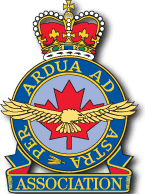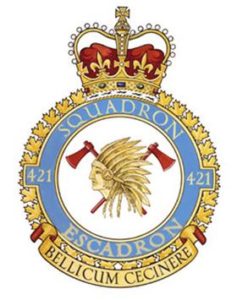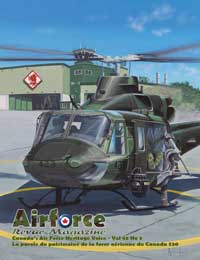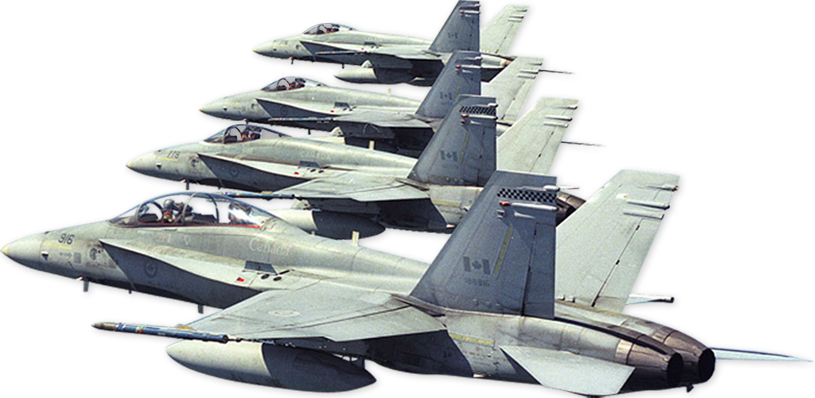 No. 421 Squadron
No. 421 Squadron
Badge: In front of two tomahawks in saltire, a Red Indian warrior’s headdress
Motto: Bellicum cecinere (They have sounded the war trumpet)
Authority: King George VI, September 1944
The Canadian Red Indian is well known for his courage and fighting qualities and with the tomahawks, his traditional weapon, makes an appropriate device for a fighter squadron.
Formed at Digby, Lincolnshire, England on 9 April 1942 as the RCAF’s 20th – eighth and last Fighter – squadron formed overseas, the unit flew Spitfire aircraft on offensive and defensive air operations; and in close support of ground forces in North-West Europe. The squadron was disbanded at Utersen, Germany on 10 July 1945.
Brief Chronology: Formed at Digby, Lines., Eng. 9 Apr 42. Disbanded at Utersen, Ger. 10 Jul 45.
Title or Nickname: “Red Indian” (1)
Adoption: McColl-Frontenac Oil Company of Canada
Commanders
- S/L F.W. Kelly 9 Apr 42 – 13 Jul 42.
- S/L F.C. Willis (Can/RAF) 14 Jul 42 – 8 Nov 42 KIA.
- S/L F.E. Green, DFC 17 Nov 42 – 12 Apr 43 OTE.
- S/L J.D. Hall, DFC 13 Apr 43 – 16 Jun 43.
- S/L R.W. McNair, DFC and 2 Bars 19 Jun 43 – 16 Oct 43.
- S/L C.M. Magwood, DFC 17 Oct 43 – 12 Dec 43.
- S/L J.F. Lambert 13 Dec 43 – 20 Dec 43 KIA.
- S/L W.A.G. Conrad, DFC 1 Jan 44 – 27 Jul 44 2OTE.
- S/L W.A. Prest 28 Jul 44 – 22 Nov 44 OTE.
- S/L J.D. Browne, DFC 23 Nov 44 – 10 Jul 45.
Higher Formations and Squadron Locations
Fighter Command:
No. 12 Group, Canadian Digby Wing,
- Digby, Lines. 9 Apr 42 – 2 May 42.
No. 10 Group,
- Fairwood Common, S. Wales 3 May 42 – 14 Oct 42.
No. 17 Armament Practice Camp, Warrnwell, Dorset 14-28 Jun 42.
- 14 aircraft, Exeter and Bolt Head, Devon. 30 Jun – 8 Jul 42.
- 14 aircraft, Kenley, Surrey 8-10 Oct 42.
- Angle, S. Wales 15 Oct 42 – 28 Jan 43.
- 14 aircraft, Zeals, Wilts. 21-24 Oct 42.
- Exercise, Charrny Down, Sorn. 30 Nov – 3 Dec 42.
No. 11 Group, Canadian Kenley Wing,
- Kenley, Surrey 29 Jan 43 – 22 Mar 43.
- Exercise, Croughton, Beds. 1-12 Mar 43.
- 8 aircraft, night fighter duty, Manston, Kent 19-25 Mar 43.
- Redhill, Surrey 23 Mar 43 – 16 May 43.
No. 15 Armament Practice Camp, Martlesharn Heath, Suffolk 10-21 Apr 43.
- Kenley, Surrey 17 May 43 – 4 Jul 43.
Second Tactical Air Force:
No. 83 (Composite) Group,
No. 17 (RCAF) Sector (disbanded 13 Jul 44),
No. 127 (RCAF) Wing,
- Kenley Surrey 5 Jul 43 – 5 Aug 43.
- Lashenden, Kent 6 Aug 43 – 19 Aug 43.
- Headcorn, Kent 20 Aug 43 – 13 Oct 43.
- Kenley, Surrey 14 Oct 43 – 17 Apr 44.
No. 16 Armament Practice Camp, Hutton Cranswick, Yorks. 2-9 Mar 44.
- Tangmere, Sussex 18 Apr 44 – 15 Jun 44.
- B.(Base) 2 Bazenville, Fr. 16 Jun 44 – 28 Aug 44
- B.26 Illiers l’Eveque, Fr. 29 Aug 44 – 21 Sep 44.
- B.68 Le Culot, Bel 22 Sep 44 – 30 Sep 44.
- B.82 Grave, Neth. 1 Oct 44 – 22 Oct 44.
- B.58 Melsbroek, Bel. 23 Oct 44 – 2 Nov 44.
- B.56 Evere, Bel. 3 Nov 44 – 1 Mar 45.
No. 17 Armament Practice Camp, Warrnwell, Dorset, Eng. 6-20 Dec 44.
- B.90 Petit-Brogel, Bel. 2 Mar 45 – 30 Mar 45.
- B.78 Eindhoven, Neth. 31 Mar 45 – JO Apr 45.
- B.100 Coch, Ger. 11 Apr. 45 – 13 Apr 45.
- B.114 Diepholz, Ger. 13 Apr 45 – 27 Apr 45.
- B.154 Soltau, Ger. 28 Apr 45 – 1 Jul 45.
- B.152 Fassberg, Ger. 2 Jul 45 – 7 Jul 45.
- B.174 Utersen, Ger. 8 Jul 45 – 10 Jul 45.
Representative Aircraft (Unit Code AU)
Supermarine Spitfire Mk.VA (May 42, not on operations)
Supermarine Spitfire Mk.VB (May 42 – May 43)
- AR430 Z BL450 M BL658 Y BL772 S
Supermarine Spitfire Mk.IX (May 43 – Feb 44)
Supermarine Spitfire Mk.IXB (Feb – Dec 44)
Supermarine Spitfire Mk.XVI (Dec 44 – Jul 45)
Operational History: First Mission 16 May 1942, 2 Spitfire VB’s from Fairwood Common – convoy patrol.
First Victory: 6 July 1942, F/L G.D. Robertson in Spitfire VB BL772 AU-S from Fairwood Common – scrambled, credited with a Bf.109 damaged over the Channel. (On a second scramble later that day, he was credited with a Ju.BB damaged over the Channel.) 27 July 1942 Sgt. C.D. Myers and Sgt. J.A. Omand in Spitfire VB’s from Fairwood Common – scrambled, shared in destruction of a Ju.88 south of Pembroke, Wales.
First Offensive Mission: 31 July 1942, 8 Spitfire VB’s from Fairwood Common, operating from Harrowbeer for the day – rear cover for Bostons returning from a raid over St. Malo, France.
Triple Victory: 25 July 1944, 12 Spitfire IXB’s from Bazenville – armed reconnaissance in the Pont l’Eveque-Seine area, engaged 40-plus Bf.109’s, credited with 5 destroyed, 1 probably destroyed and 3 damaged for the loss of 1 Spitfire. F/L H.P.M. Zary in MK920 credited with 3 Bf.109’s destroyed southeast of Rouen, France.
Last Mission: 4 May 1945, 4 Spitfire XVl’s from Soltau – front line patrol along Hamburg-Luneburg, engaged Fw.190’s flying south. No claims, no losses.
Summary Sorties: 10,915.
- Operational/Non-operational Flying Hours: 14,609/8216.
- Victories:
- Aircraft: 79 destroyed, 2 probably destroyed, 27 damaged.
- Ground: dropped 45 tons of bombs, no reliable record of damage.
- Casualties:
- Operational: 34 aircraft; 33 pilots, of whom 4 were killed, 25 missing, 4 injured.
- Non-operational: 2 aircraft; 2 pilots killed.
Squadron Aces: S/L R.W. McNair, DFC and 2 Bars 8 destroyed. F/L P.G. Johnson 5 destroyed.
Honours and Awards: 1 second bar to DFC, 2 bars to DFC, 5 DFC’s.
Battle Honours:
- Defence of Britain 1942-1943.
- Fortress Europe 1942-1944.
- France and Germany 1944-1945. Normandy 1944, Arnhem. Rhine.
(1) The squadron was unique in that its aircraft carried the familiar Indian Head emblem of the McColl-Frontenac Oil Company.









